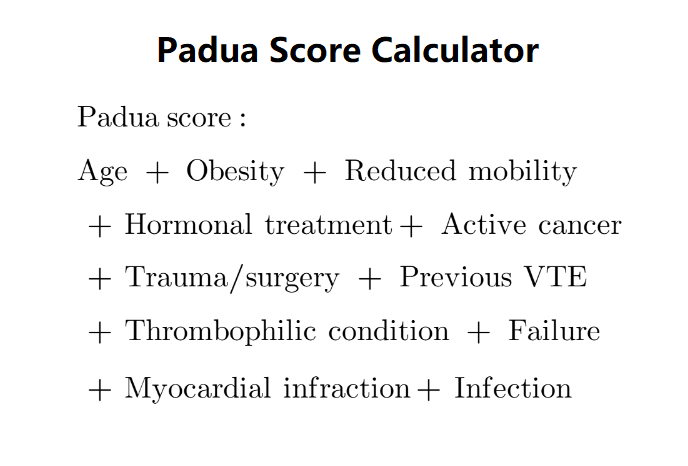1. What is the Padua Score Calculator?
Definition: The Padua Score Calculator assesses the risk of venous thromboembolism (VTE) in hospitalized medical patients by evaluating 11 clinical risk factors.
Purpose: It stratifies patients into low or high risk for VTE, guiding decisions on the need for pharmacological or mechanical prophylaxis to prevent conditions like deep vein thrombosis (DVT) or pulmonary embolism (PE).
2. How Does the Calculator Work?
The calculator sums points from 11 risk factors:
- Age ≥ 70 years: 1 point
- Obesity (BMI ≥ 30): 1 point
- Reduced mobility (bed rest ≥ 3 days): 3 points
- Hormonal treatment: 1 point
- Active cancer (or treated within 6 months): 3 points
- Recent trauma/surgery (within 1 month): 2 points
- Previous VTE (excluding superficial vein thrombosis): 3 points
- Thrombophilic condition (e.g., Factor V Leiden): 3 points
- Heart/respiratory failure: 1 point
- Myocardial infarction/stroke: 1 point
- Infection/rheumatologic disorder: 1 point
Interpretation of the Padua Score:
- <4 points: Low risk. (Pharmacological prophylaxis not recommended; consider mechanical prophylaxis.)
- ≥4 points: High risk. (Pharmacological prophylaxis indicated; consider anticoagulation like enoxaparin.)
Inputs:
- Presence (Yes/No) of each of the 11 risk factors.
Steps:
- Indicate the presence of each risk factor by selecting Yes or No.
- Calculate the Padua Score by summing the points for each present risk factor.
- Interpret the risk level and provide a recommended action for VTE prophylaxis.
3. Importance of Padua Score Calculations
The Padua Score calculation is useful for:
- Risk Stratification: Identifies patients at high risk of VTE, enabling targeted prophylaxis.
- Preventing VTE: Guides the use of pharmacological or mechanical prophylaxis to reduce the incidence of DVT and PE.
- Improving Patient Safety: Enhances hospital safety by ensuring high-risk patients receive appropriate preventive measures.
4. Using the Calculator
Examples:
- Age ≥ 70: Yes, Obesity: No, Reduced mobility: No, Hormonal treatment: No, Active cancer: No, Trauma/surgery: No, Previous VTE: No, Thrombophilic condition: No, Heart/respiratory failure: No, Myocardial infarction: No, Infection/rheumatologic disorder: No:
Padua Score: \( 1 + 0 + 0 + 0 + 0 + 0 + 0 + 0 + 0 + 0 + 0 = 1 \).
Risk Level: Low risk.
Recommended Action: Pharmacological prophylaxis not recommended. Consider mechanical VTE prophylaxis.
- Age ≥ 70: Yes, Obesity: Yes, Reduced mobility: Yes, Hormonal treatment: No, Active cancer: Yes, Trauma/surgery: No, Previous VTE: Yes, Thrombophilic condition: No, Heart/respiratory failure: Yes, Myocardial infarction: No, Infection/rheumatologic disorder: Yes:
Padua Score: \( 1 + 1 + 3 + 0 + 3 + 0 + 3 + 0 + 1 + 0 + 1 = 13 \).
Risk Level: High risk.
Recommended Action: Pharmacological prophylaxis indicated. Consider guideline-based anticoagulation (e.g., enoxaparin 20–40 mg daily).
5. Frequently Asked Questions (FAQ)
Q: What is the Padua Score?
A: The Padua Score is a risk assessment model that predicts the likelihood of venous thromboembolism (VTE) in hospitalized medical patients based on 11 clinical risk factors.
Q: When should pharmacological prophylaxis be considered?
A: Pharmacological prophylaxis is recommended for patients with a Padua Score ≥ 4, indicating high risk, unless contraindicated (e.g., high bleeding risk).
Q: What is VTE?
A: Venous thromboembolism (VTE) includes deep vein thrombosis (DVT) and pulmonary embolism (PE), conditions caused by blood clots forming in veins, often linked to factors like stasis, endothelial injury, and hypercoagulability (Virchow’s triad).
 Home
Home
 Back
Back
